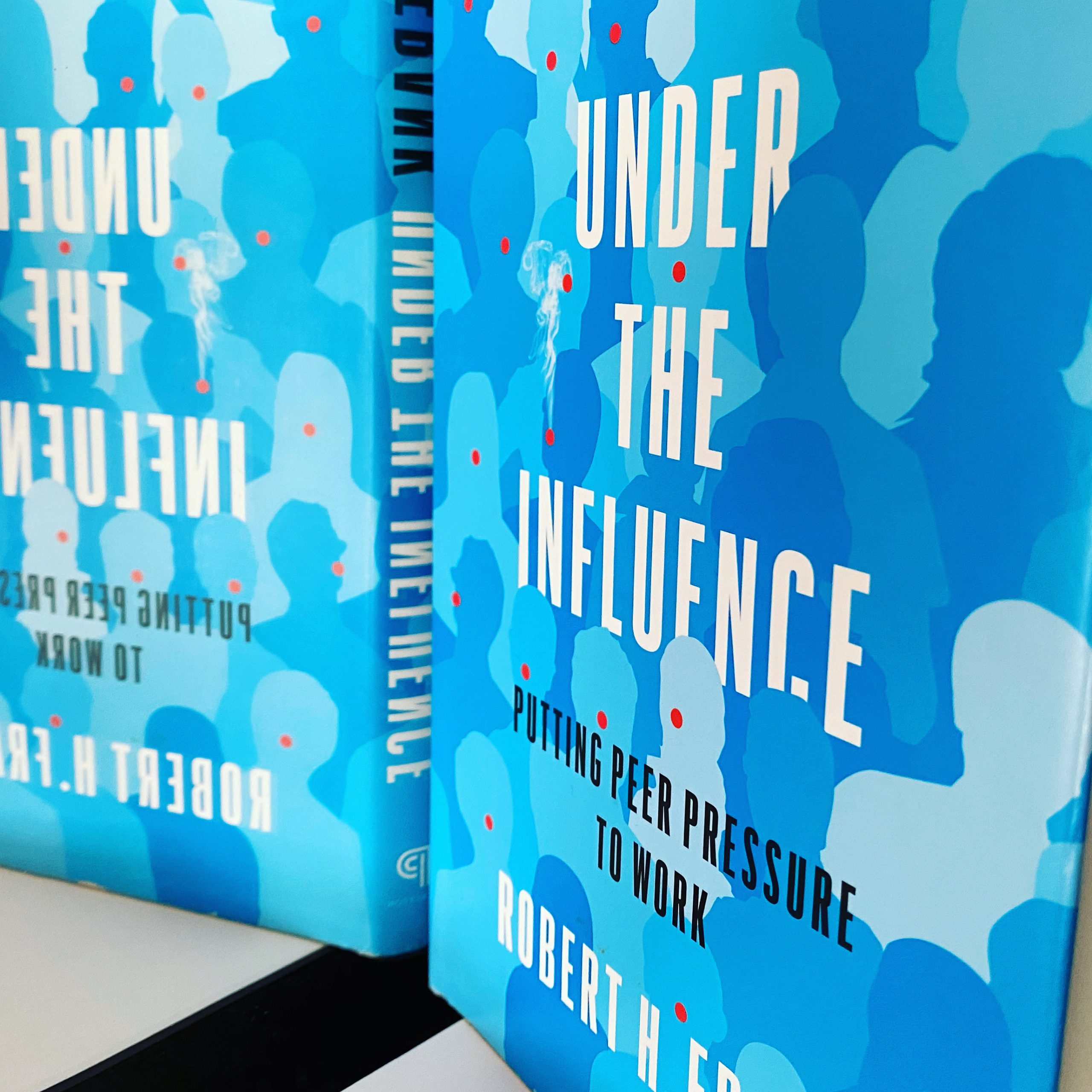In new book Under the Influence: Putting Peer Pressure to Work, Robert H. Frank makes the case that, given how powerful behavior is as a contagion, it is prudent to put this to good use.
The Power of State-Created Reality: An Interview with Debi Cornwall
Debi Cornwall is an American conceptual artist whose projects critically reflect on state power. Her first book, Welcome to Camp America: Inside Guantánamo Bay (Radius, 2017), was a study of the so-called “detention center” in which prisoners are held often for years without charge or trial. Gitmo represents a strange materialization of post-9/11 America, in which “the land of the free” was confronted with its willingness to tolerate false imprisonment and torture, and its reluctance to self-govern its appetite for war. Given Cornwall’s background as a wrongful conviction lawyer, it was a suitable and searing perspective. Now, in her forthcoming book Necessary Fictions (Radius, 2020), Cornwall turns her focus to the mock-villages where soldiers play war in stage-settings of faraway lands, complete with roleplaying actors and gruesome make-up. In this interview, we speak about state-based reality, the Fantasy Industrial Complex, and the performance of power.
Your series is set in the military’s fictional country of “Atropia”, based vaguely on Afghanistan or Iraq. It’s an odd interpretation of a livable city: the buildings are candy colored, and overall it’s bare and bland. What is it like to be there?
It feels like being on a stage set that has been partially dressed, as though the set dresser got halfway through and then walked off the job. These are mock villages on ten different sites on military bases across the country, but what they have in common is most of the buildings are made of shipping containers, sometimes covered with fake adobe. There are pots stacked in front of the florist, fake plants and a cash register inside, but in the next building over there’s a prayer rug on the floor and nothing else. A minaret atop the “mosque” but no call to prayer. So, it’s disorienting. It feels as though it’s a gesture in the direction of reality. What struck me, over and over, were the gaps between the staging and reality.
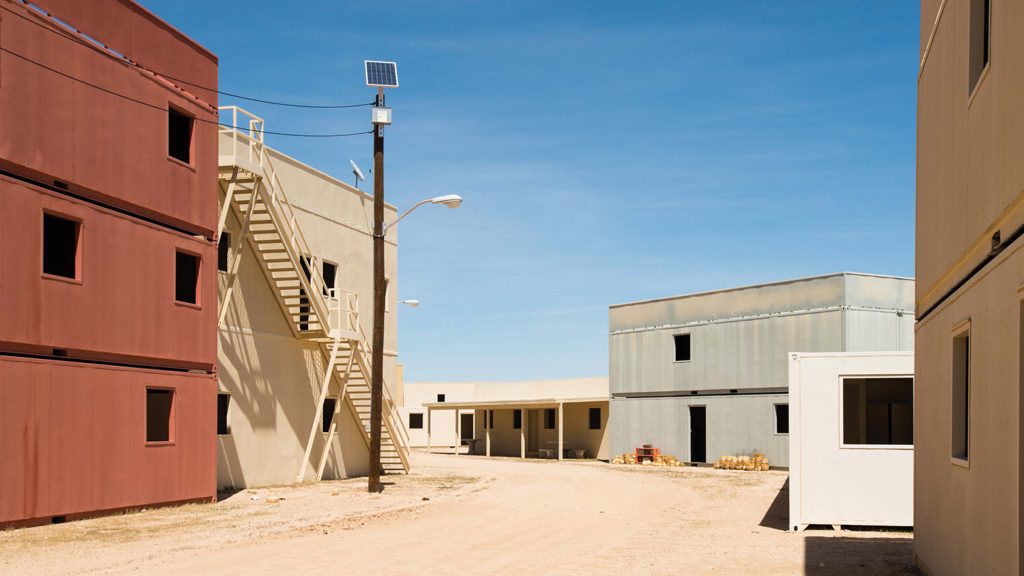

Tell us about the title, Necessary Fictions. Why are these fictions “necessary”?
The title is really more of a question, or a provocation. There’s a quote from Karl Rove [President George W. Bush’s chief political strategist] at the beginning of the book, which really sets up everything: “We’re an empire now, and when we act, we create our own reality.” My practice is to study state-created realities. Even setting aside the critically important project of battling truth against lies, if we understand the exercise of state power as a performance, the focus shifts. What is the goal of this performance? What’s in it for those staging this show? How does it impact the rest of us? It opens a whole new window of understanding.
From the state perspective, all of these fictions are necessary. It’s necessary to make a game of war, not only to prepare our troops but also so that war is embedded here at home, within what Ben Fountain calls the “Fantasy Industrial Complex”—the avalanche of products, entertainment, and fantasy distractions that ensure we often don’t know what’s real. Just as it is necessary to tell other kinds of stories about our domestic reality and about how government is serving us. The title, “Necessary Fictions”, is a commentary on this state performance.
Especially over the last few years, it’s become increasingly difficult to agree on a common reality. All our realities—as individuals, as communities, as nations—end up competing. What role do you think a state reality plays?
State-created realities are designed to perpetuate power by those who hold it, no matter who is in office. The plainest evidence of this is the wave of Black Lives Matter protests sweeping the U.S. and the world in the wake of George Floyd’s murder. Despite the official messaging that police “protect and serve”, Black* communities know better from daily personal experience. White America, suddenly and at long last, is waking up to the disconnect.
As consumers of state-created realities, we too have our own varied realities. We can see this with the Covid-19 situation in the United States: My reality in New York City—where we were in extended lockdown and have loved ones who have been desperately ill or have died, and all we heard was birds and ambulance sirens—was for months a very different reality from someone in a more rural or sprawling part of the country where they didn’t have a high curve and don’t know anyone who’s sick. For them, life just went on as usual. That is shifting now, but it seems that at least in the United States, we’re each destined to relate to this pandemic in a very different way until it has touched us personally.
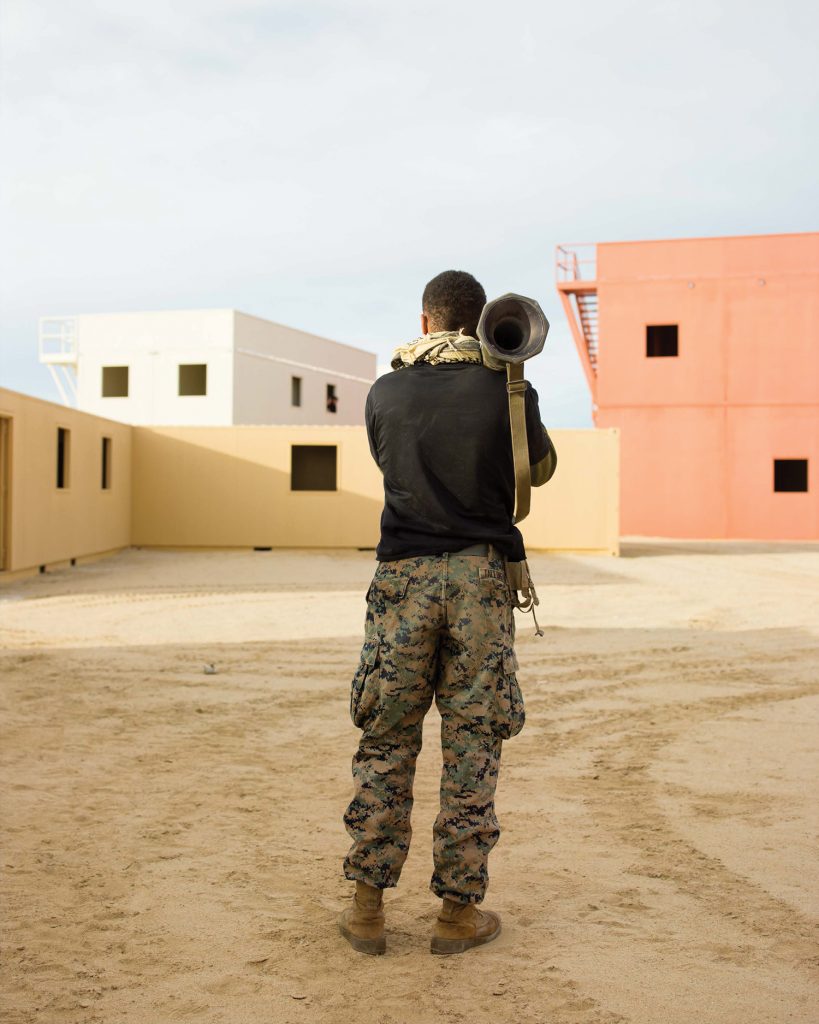
How does the creation of this state reality apply to the cultural roleplayers—the civilians who play Atropian residents in the war games?
I think there’s a sense of community among them that is unique. I mean, the war games are essentially uninterrupted time: roleplayers don’t have their cell phones, there’s no internet service, they are talking and cooking and eating and passing the time together. That is a powerful and important experience on a human level.
When I asked them why they do this work, the most common response I got was, “We want to save lives—American lives, Iraqi lives, Afghan lives. Because if they can learn from us, we’ll head off misunderstandings and deaths.” That is a laudable goal and at the same time I wonder if it’s wishful thinking. Do these war games save lives more than they perpetuate forever wars? I don’t know. The reality is that it’s a well-paying job.
The military is shifting away from these kinds of games as warfare becomes ever more remote, more drone-oriented, more focused on technology. Assuming the wars continue—which I think is safe to assume—I don’t know if in five to ten years they’re still going to be hosting cultural roleplayers and spending that money when they could do it all in a simulation. We’ll see. Those are other fictions, and whether the calculus ends up being a net benefit to humanity is another question.
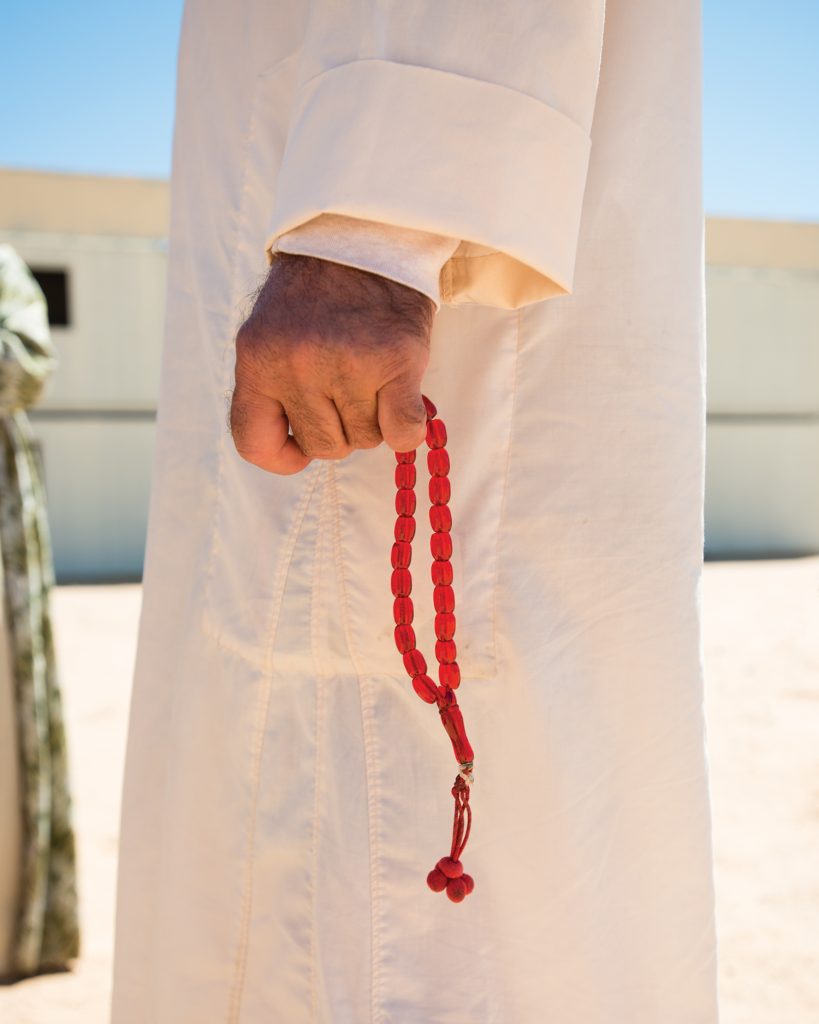
In this book, you serve as narrator, with several of the texts being written from your own perspective. Why introduce yourself as an “I” in the book?
For a couple of reasons. My work, which uses formal composition and typology to tackle systemic questions, may feel static, so I’m always looking for ways to add layers that will invite viewers into a more personal perspective. Also, I felt like a character in these environments. I wasn’t asked to embed or put on a costume, but I definitely was a player. I was not a fly on the wall, to use that defunct documentary expression. I influenced what was happening in my presence, certainly with the portraits, less so in the photojournalistic-looking pictures of soldiers and “police” on the move, where I was running after people and trying not to get in the way.
Because I’m interested in the disconnect between the reality and the performance, bringing in my reality was a way to emphasize those disconnects and those slippages. I like to think of my work less as making a statement, and more as teeing up questions. A narrator introduces an “I” who can frame questions for the reader to grapple with—if she is willing.
In the book you write that one of the main purposes of these war games is that, “Pre-deployment training […] can reduce the risk of PTSD.” The suggestion seems to be that the human mind wasn’t built to cope with the atrocities of war, so we must inure ourselves to atrocities so that we’re better able to commit them. What are your thoughts on this?
My views on it developed over the three years I spent visiting Atropia (and Dinovia, and other fictional countries), and more so after the fact of being there. While I’m there, in those spaces and interacting with people, my goal is to be present, to understand, and to connect. Only later do I assess or try to make sense of that I experienced. I’ve read the studies that support the idea that enacting trauma helps “inoculate” against its effects, but I’m skeptical.
Do you think the moulage or the war games help to achieve the military’s goal of generating the “psychological fidelity” of war?
First, I need to clarify that there are a number of different scenarios. There are scenarios where the training force needs to infiltrate the town and build relationships with the locals and suss out who’s a “bad guy”; there are scenarios that are more militaristic, where you’ve got to move in and fight the opposing force; and then there are mass-casualty event scenarios, in which sometimes the cultural roleplayers but often the military members themselves are dressed in “moulage”—fake injuries painted on by Hollywood makeup artists—and then are placed out around the environment for the medics to triage.
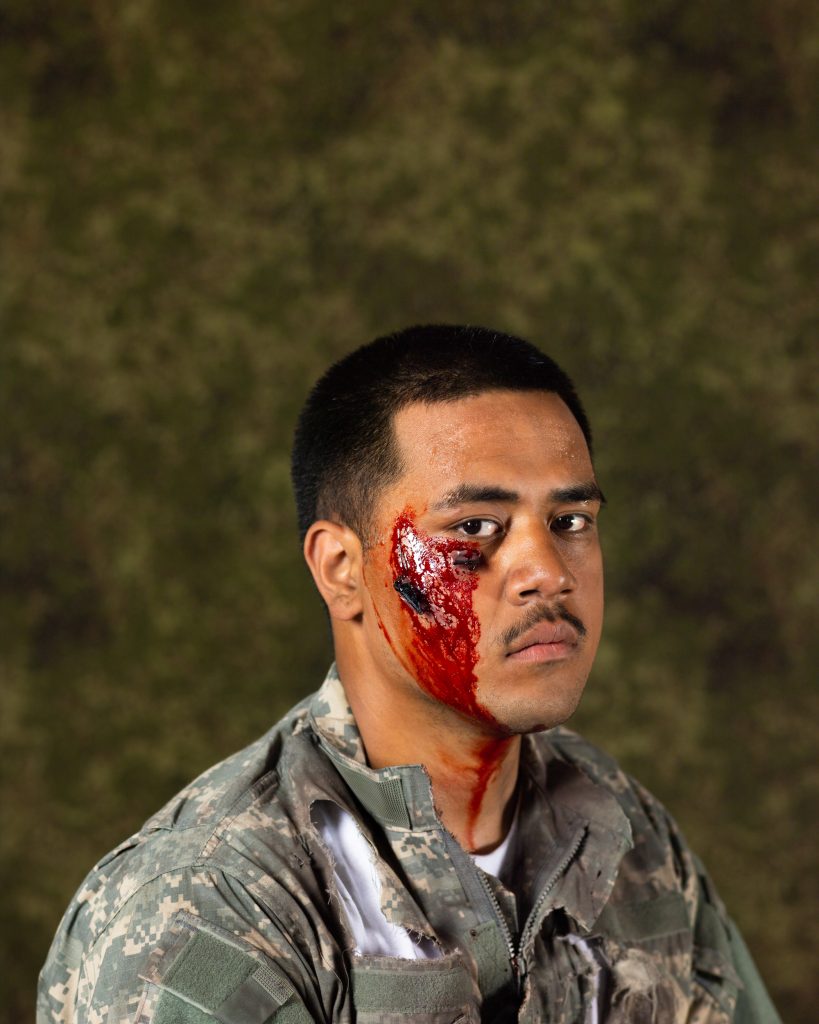
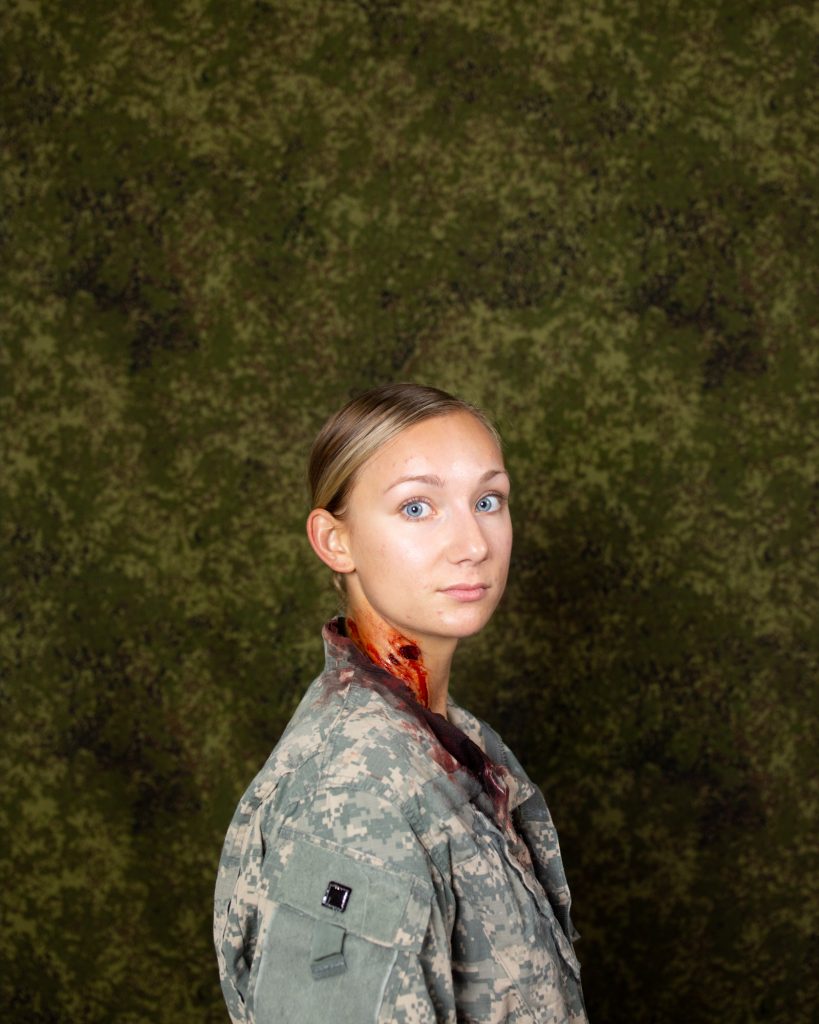
Enacting triage scenarios with moulage is a proven technique for medics, whether military or civilian. And for the training forces, going through the motions of interacting with townspeople, walking through the towns, seeing the sights, sometimes even the smells are recreated… I think that has potential. Honestly, for an American kid who’s never been out of the country and has never heard a foreign language, it’s an important experience to have, just to hear Arabic or Pashto or Dari spoken before they arrive, or to hear a call to prayer. Whether that’s fidelity or not, it gives a sense of what it’s like to be in another environment, and I think that is valuable. It speaks to the different realities we have based on our respective lived experiences. I used COVID-19 as an example, but those of us who have diverse circles or those of us who have traveled, have a different lived reality than those who have stayed among their own. At the same time, in these scenarios, there are slippages, obvious un-realities, and gaps. The bullets are blanks. The games are halted whenever someone finds a live round. By definition, the games are not life-or-death.
I don’t think anyone’s claiming that the use of moulage will inoculate soldiers to the trauma of being injured, since the exercises are to train the medics for mass-casualty events. But it’s worth asking what is the effect on the soldiers. Many of these kids are still teenagers, which is part of the reason why some of their portraits are smiling, in the style of school class pictures. Except they’re in moulage—they’re bloody graduates! I went into those sessions intending to make somber, respectful portraits. One day, one of the soldiers asked if we could do a picture smiling for his girlfriend. I saw the first test and was jolted by it, because of the disconnect between the injuries and the smile. So I began asking others if they wanted to do a version smiling or not. It feels like a distancing technique, a very human reaction. Like, “I’m going to make a joke of this because if I took it seriously, that’s going to freak me out.” I’ve stayed in touch with some of them, and hope to be in conversation with them after they’ve returned from their various deployments, to start to answer that question.
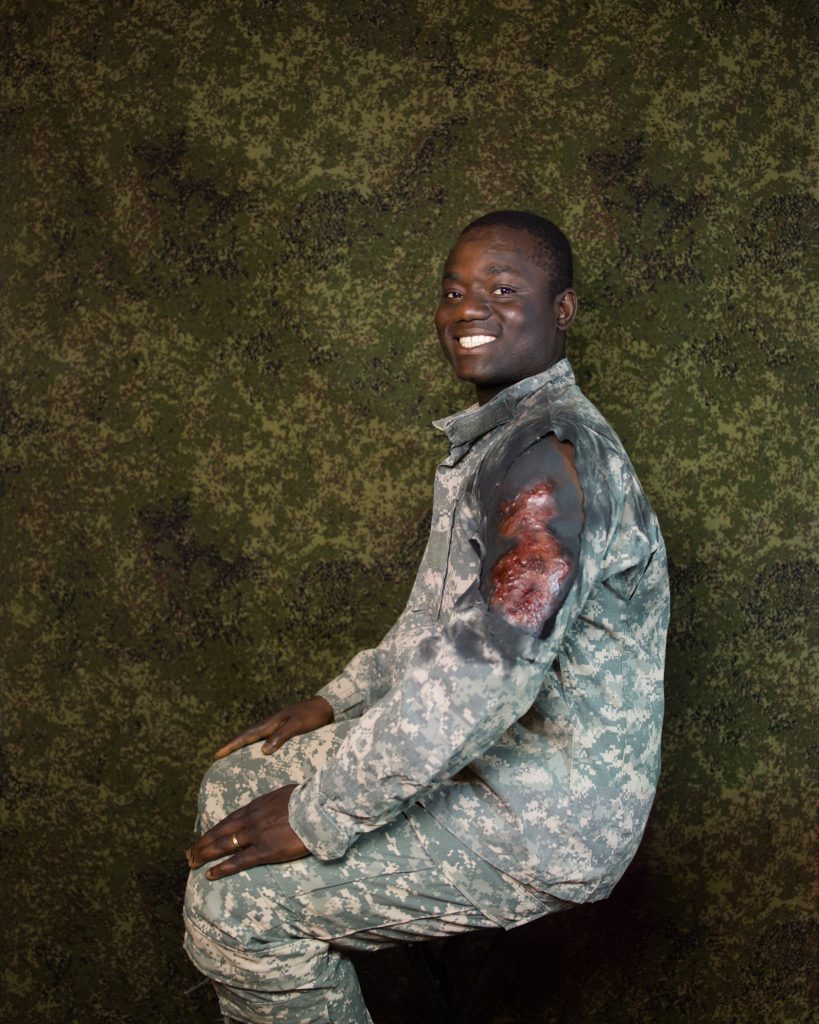
Since it’s essentially a Middle Eastern, Muslim nation that’s represented by Atropia, do you think there is a risk of the soldiers practicing an association of those languages, those religions, or those skin colors with combatants and enemy peoples to be infiltrated?
That’s a very good question. Part of the trainings I saw were intended to encourage soldiers, marines, and national guardsmen and -women to cultivate relationships with villagers and learn to distinguish who is a civilian posing no threat and who is a “troublemaker” or an insurgent. I will say that in speaking to the roleplayers and even some consultants—I write about both in the book—there’s a question as to what is being learned. The training force does not always check back in with the cultural roleplayers after a scenario to ask, “How did we do?” The trainers do “after-action reports” with the trainees, but the cultural roleplayers told me, for example, “They did that all wrong. They spoke to the person at the front of our group, but that’s not how it works, you have to identify the elder. It’s important to know that, but nobody asked us.” So, again, is all of this for show? If it’s really about fidelity and understanding and saving lives, more could be done.
You and I have spoken before about the Stanford Prison Studies, an experiment in which people roleplayed prisoners and jailers. Putting aside the acknowledged shortcomings of the study, the findings are still relevant here: when we role-play, we aren’t being ourselves, we’re portraying a construction of what we think a “prisoner” or a “jailer” is. If in these war games, people are playing “insurgents” and “soldiers,” could these fictional scenarios then reproduce our roles in the real world, as a matter of life imitating art imitating life?
It’s all simulacrum! I think I avoided using that word in the book, but it’s an appropriate word. I also think of Stanley Milgram’s Obedience to Authority and sociologist Erving Goffman’s The Presentation of Self in Everyday Life, from 1956. He basically says that all of life in society is a performance. We can think about it in terms of “backstage” and “onstage”, and who we are at home when no one’s looking is backstage, but as soon as we are interacting with anybody we’re onstage and we’re presenting ourselves, selecting what to show, creating a script consistent with our public character. From Goffman’s perspective, the performance is necessary—we can’t really share all of ourselves all the time, it would make us too vulnerable.
I’m having a revelation through making this work—that it’s all about performance, on every level. What’s happening with wars and policing, all of it.
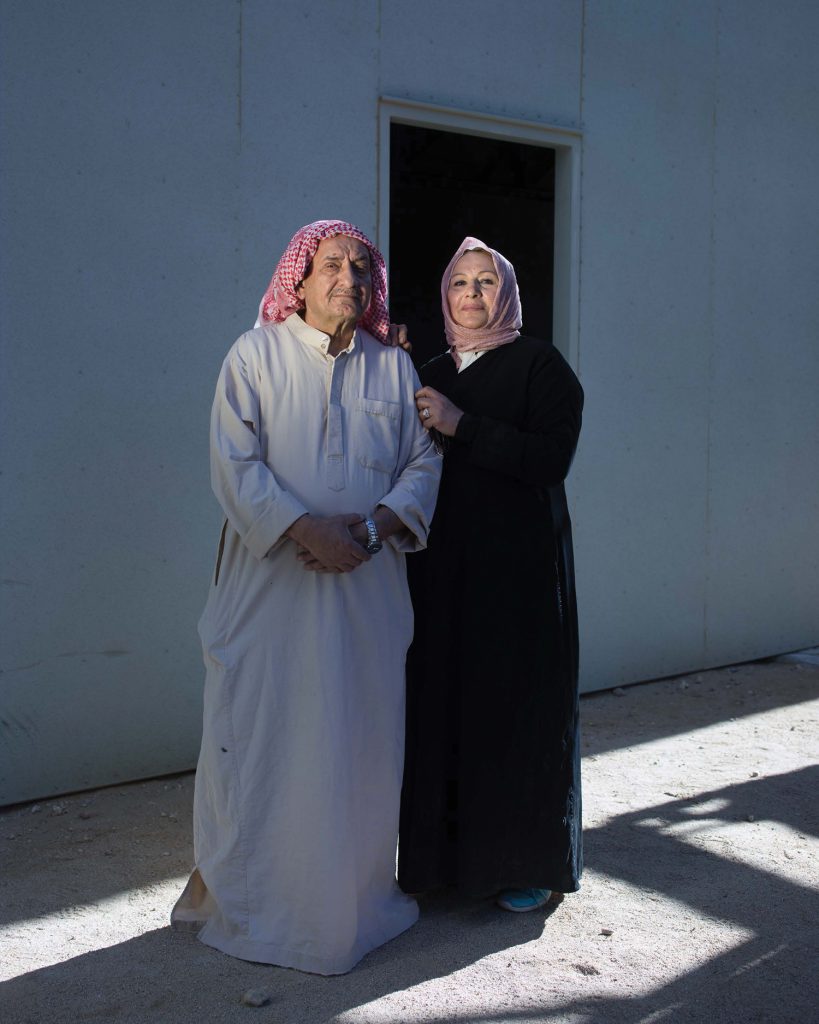
You intermix texts from various sources: sales text from war commerce, anecdotes from interviewees that may or may not be true, actual news articles, parody news articles, etc. At every step of the way, we’re taken deeper into a narrative with an increasingly blurry line between truth and fiction. What is the meaning behind this?
We are living in a time of forever wars abroad, while at home we are politically divided and constantly on red alert for threats. The state is disseminating its own reality, and we as a people are resorting to fictions to manage what the advertisers have taken to calling “these uncertain times.” Within this Fantasy Industrial Complex, fictions are our respite, our relief. For me, looking at the fictions, how state power deploys fictions and how the rest of us consume or even perhaps embrace them, the commodification of it all—it’s like seeing the Matrix. Rather than saying “this is true” or “this is false”, I’m more interested in using the lens of performance to understand these systems. I think it’s important for us to examine and ask questions about them, so perhaps we can move to a different stage.
What is that next stage?
I haven’t envisioned it yet, honestly. I’ve been so focused on understanding the performance, the staging, and the embrace of fictions, which feels all-encompassing from every perspective, that I haven’t yet been able to imagine what comes next. But perhaps we’re starting to get a glimpse of it with the national reckoning that’s now starting to take place in the wake of the renewed Black Lives Matter movement.
Given the Fantasy Industrial Complex, and that we are all consumers of war—
—From a safe distance!
Can you imagine an end to war? Does the violence ever stop, or are we too much of a consumer to stop buying into it?
Well, I’m certainly under no illusion that my pictures will do that, but some of the American reactions I’ve gotten to the moulage pictures are so visceral that they speak to a window of possibility. In the book, I quote someone whose son is in the service, and who looked at some of the moulage pictures and was really outraged: “How dare they dress up our soldiers like extras in a B-movie version of Casualties of War. How dare they make a mockery of our active-duty servicemembers!”
It feels like there’s an opportunity there. In seeing a depiction of our soldiers injured—to reiterate, I didn’t make them up that way, the military is dressing them that way as part of their training—it has the capacity to touch that nerve. What is underneath that reaction, which ostensibly is about disrespect? Maybe it’s motivated more by fear of the reality that our soldiers could end up that way. We don’t typically see them when they’ve been injured. For many years the American press was barred from publishing photographs of flag-draped coffins of fallen soldiers.
I think the people who react with shock at seeing the injured soldier have the capacity to be part of the larger conversation about American violence and militarism and the ways in which that’s structurally embedded in who we are as a country. That’s analogous to how the cellphone videos and dashcam videos and images of Black men killed by the police are making us confront the realities of how power deploys violence against black and brown bodies at home. These are two parallel conversations that are starting to be connected. As the Rev. William Barber II put it in a recent article, police “militarism at home is linked inextricably to U.S. militarism abroad.” This may well be the next chapter of our current conversation.
But of course not everyone reacts the same way.
I’ve actually started to get people’s reactions to the moulage portraits, as an anecdotal experiment. I would stop random strangers in American airports and say, “I’m an artist and I’m making photographs of American soldiers and I wonder if you have a few minutes to take a look at them and tell me what you see, what comes up for you, good or bad.” So far, I’ve talked to ten or twelve people this way, but the reactions were starkly divided by gender—again, this is purely anecdotal, not scientific! Most of the men would look and say, “This is obviously fake,” and hand back my phone. So, for them, the fiction was an excuse to not look at the reality that it was signifying. The women overwhelmingly got emotional and said, “We don’t ever get to see this, we don’t see what happens to our soldiers.” An older white man in a “Veterans for Trump” t-shirt said, “This is real. I see the tragedy of war.” I’m fascinated by those who react to the reality in these fictions.
I think we often don’t like to look at the thing itself, because we’re exhausted. We’re bombarded. It’s too much. The value of art is we can invite people to look at things through a side door. A pretty picture, or a picture that is fictional or staged, can prompt a visceral reaction that is about something real. Again, we all have different realities, so some of us look at the staged pictures, see that it’s “fake”, and don’t have to think about the reality that it signifies, while others see an opportunity in the staged image to grapple with the emotional and empirical reality that it signifies. Those reactions can be the start of a conversation. And it’s a different conversation within the United States than it is anywhere else.
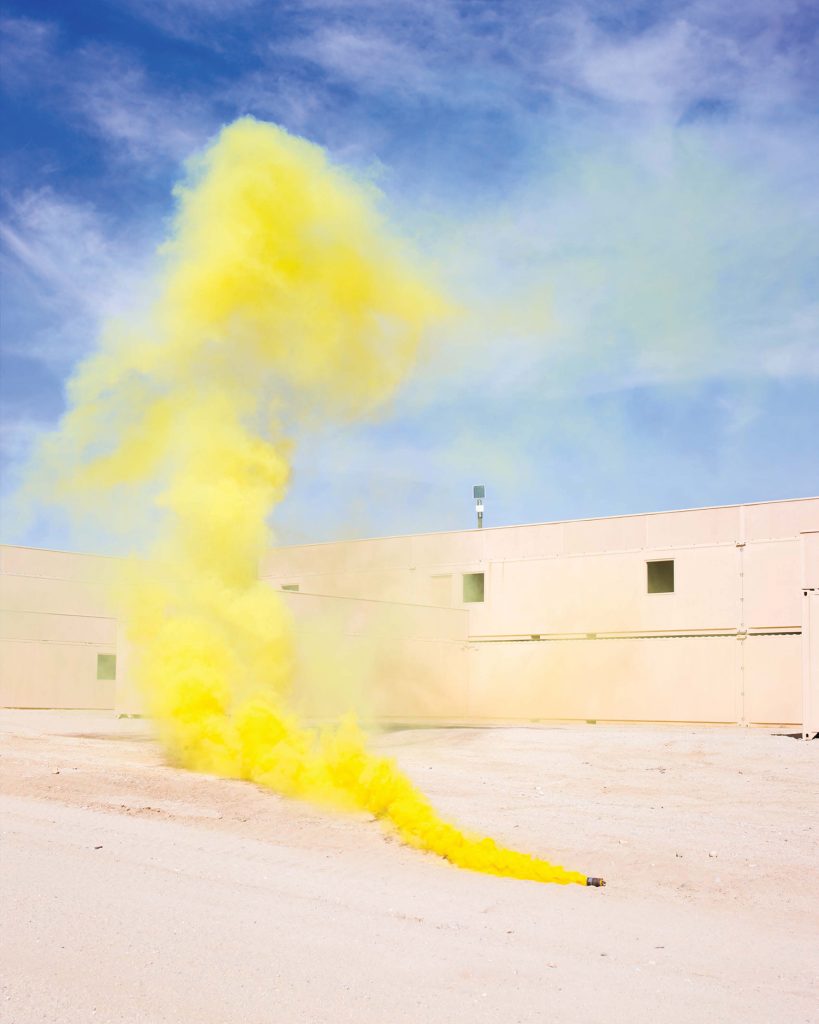
You’ve previously worked as a wrongful conviction lawyer, and you told me that your work representing Black men fatally shot by police turns out to be highly relevant here. Can you give us some context?
I was a plaintiff’s lawyer in civil rights lawsuits, so I represented both DNA exonerees—a practice that informed my visual work on Guantánamo—and also victims of police abuses. So, for example, I represented the family of a Black man who was shot by a white rookie officer during a traffic stop in Chattanooga, Tennessee. I reviewed the police officer’s actions against his training and the supervision, as well as best practices, and cross-examined him and his partner in depositions. That lawsuit had twin goals: to win compensation for those whose rights had been violated, and to identify, expose, and change systemic misconduct.
In looking at war games, one could say, “That’s happening on military bases, what does it have to do with us?” Well, what’s happening on military bases has to do with perpetuating the forever wars in Afghanistan and Iraq and beyond—certainly since September 11, but even before that. These military interventions, prosecuted against brown and black, Muslim, and Arab countries, are not separate from what’s happening here at home. I look at how the wars abroad affect domestic American life in two ways: by looking at the industry that has built up around the games with consultants, propmakers, and roleplayers, and by looking at instances in which the war games have spread beyond the confines of military bases.
One example is Jade Helm 15: In 2015, U.S. military forces conducted war games across seven southern states. In the process of making communities aware of their plans and seeking permission to operate in these locations, there was a backlash from citizens who thought these exercises were a front for the Obama administration to confiscate their weapons and impose martial law. Several men were arrested and pled guilty to conspiring to ambush the exercises with bombs and automatic weapons.
Then there’s the Pineland story, a separate incident, of a routine traffic stop that went horribly wrong. A deputy sheriff on traffic control pulled over a suspicious vehicle. The occupants’ answers to his questions didn’t add up. There was a struggle, things escalated, and he shot two men, one of whom died. “I shot the dark-skinned one first,” the deputy later testified. He learned too late that the “suspects” were undercover special-forces soldiers doing an immersive realistic military training scenario to infiltrate the fictional country of Pineland as part of their final exam to become Green Berets. The soldiers thought the police officer was playing a role in their war game. So the war games bleed into our daily reality—that in the United States includes a disproportionate fatal use of force by police against “dark-skinned” bodies. These are not disconnected phenomena.
What are the fictions that we should consider when thinking about the recent unrest triggered by the murder of George Floyd?
Since just before George Floyd’s murder, I’ve been working on part of the installation for Necessary Fictions that tells the Pineland story with archival police training films and PSAs. There is a disconnect in that material: the public service announcements present an “Officer Friendly here to protect and serve you,” while the training films directed at police essentially say, “You will be confronted with violence at every step of the way, so you must be prepared to shoot first or die.”
I think there’s a similar disconnect with the war machine. On one hand we’re told war “makes us safer”, “defends the constitution”, and “protects democracy”, while, on the other hand, this obscures the monumental toll—the deaths of civilians and U.S. military personnel abroad, and the ways in which American interventions make the world measurably more dangerous and put us at risk. Militarization has increasingly infiltrated policing, again with black and brown lives bearing the brunt. What we’re seeing is a cataclysmic unmasking of state-created realities. Once the fictions are exposed, we can collectively begin to grapple with what is.
 Necessary Fictions has a publication date of 1 Sept, 2020 and is available for pre-order from Radius Books. Learn more about Debi Cornwall on her website.
Necessary Fictions has a publication date of 1 Sept, 2020 and is available for pre-order from Radius Books. Learn more about Debi Cornwall on her website.
Editor’s Note: A note on the usage of the capitalization of Black
The capitalization of Black in American English is increasingly seen as correct, though opinions are still divided, not to mention in a state of evolution. Here, in uppercase form, the emphasis is to give due recognition to an established cultural identity, while in lowercase can describe exclusively a color or skin color.
The capitalization of Black in American English is increasingly seen as correct, though opinions are still divided, not to mention in a state of evolution. Here, in uppercase form, the emphasis is to give due recognition to an established cultural identity, while in lowercase can describe exclusively a color or skin color.

